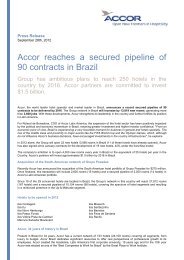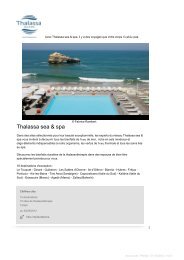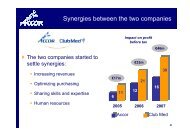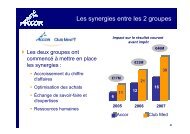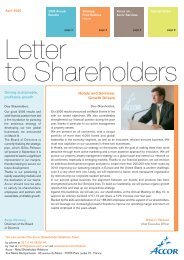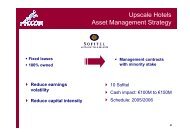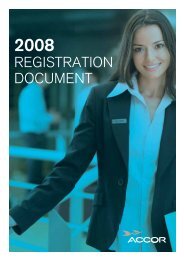SECTION 1 -
SECTION 1 -
SECTION 1 -
Create successful ePaper yourself
Turn your PDF publications into a flip-book with our unique Google optimized e-Paper software.
165<br />
New Services: Historical Combined Financial Statements and Notes<br />
December, 31, 2009<br />
• IFRS 8 – Operating Segments, which replaces IAS 14 – Segment Reporting. While IAS 14 required segment information<br />
to be presented in two reporting formats (the business segment and the geographical segment), IFRS 8 requires<br />
disclosure of information about the Group's operating segments as defined for internal reporting purposes. An<br />
operating segment is a component of an entity whose operating results are regularly reviewed by the entity’s chief<br />
operating decision maker to make decisions about resources to be allocated to the segment and assess its<br />
performance. Application of IFRS 8 has not led to any change in the definition of geographic segments compared with<br />
that applied under IAS 14. Similarly, the indicators tracked by management correspond to those already presented for<br />
the purpose of applying IAS 14. Consequently, applying the new standard has no impact on the presentation of New<br />
Services' historical combined financial statements or on the allocation of goodwill to cash‐generating units (CGUs).<br />
• IAS 1 revised – Presentation of Financial Statements: application of this revised standard led to the following changes in<br />
the structure of New Services' financial statements without any effect on its financial position:<br />
o The statement of changes in equity only shows transactions with shareholders. Other items are now included<br />
in the statement of comprehensive income.<br />
o Changes in assets and liabilities during a period are presented in two statements, a statement displaying<br />
components of profit or loss (separate income statement) and a second statement beginning with profit or<br />
loss and displaying components of other comprehensive income (statement of comprehensive income).<br />
New Services has decided to not to change the titles of its financial statements based on the titles used in IAS 1<br />
(revised).<br />
• IFRIC 13 – Customer Loyalty Programmes: application of this interpretation had no effect on reported comparative<br />
information as New Services does not have any customer loyalty programmes.<br />
• Amendment to IAS 23 – Borrowing Costs: Borrowing costs that are directly attributable to the acquisition, construction<br />
or production of a qualifying asset were already capitalized as part of the cost of that asset and the amendment<br />
therefore had no impact on the financial statements.<br />
• Amendment to IFRS 2 – Vesting Conditions and Cancellations: this amendment clarifies that all non‐vesting conditions<br />
should be taken into account in the estimate of the fair value of equity instruments granted under share‐based<br />
payment plans. It also stipulates that if an entity or the grantee can choose whether to meet a non‐vesting condition,<br />
the entity’s or grantee's failure to meet that non‐vesting condition during the vesting period should be treated as a<br />
cancellation. Application of this amendment had no effect on the financial statements for the periods presented.<br />
• Amendment to IAS 32 and IAS 1 – Puttable Financial Instruments and Obligations Arising on Liquidation: the<br />
amendment requires financial instruments puttable at fair value and obligations arising on liquidation to be classified in<br />
equity and not in debt, as was previously the case. This amendment does not apply to puts and calls on minority<br />
interests. Application of this interpretation had no effect on reported comparative information as New Services did not<br />
have any puttable financial instruments at December 31, 2008.<br />
• Amendment to IFRS 1 and IAS 27 ‐ Cost of an Investment in a Subsidiary, Jointly Controlled Entity or Associate: this<br />
amendment only applies to the separate financial statements and its application therefore had no effect on New<br />
Services' historical combined financial statements.<br />
• IFRIC 11 – IFRS 2: Group and Treasury Share Transactions: New Services early adopted this interpretation at January 1,<br />
2008. Its application had no impact on the financial statements.<br />
• IFRIC 14 – IAS 19: The Limit on a Defined Benefit Asset, Minimum Funding Requirements and Their Interaction:<br />
application of this interpretation had no effect on the financial statements for the periods presented.<br />
• Revised amendment to IAS 39 and IFRS 7 – Reclassification of Financial Assets: Effective Date and Transition. New<br />
Services has not applied the amendment to IAS 39 and IFRS 7 that allows the reclassification of certain financial assets,<br />
as it would have no effect on the historical combined financial statements for the periods presented.<br />
• Amendments to IFRIC 9 and IAS 39 “Embedded Derivatives”. New Services has not applied the Amendment to IAS 39<br />
and IFRS 7, which has since been revised and allows the reclassification of certain financial assets. Consequently,<br />
amendments to IFRIC 9 and IAS 39 have no impact on the Group’s financial statements.









